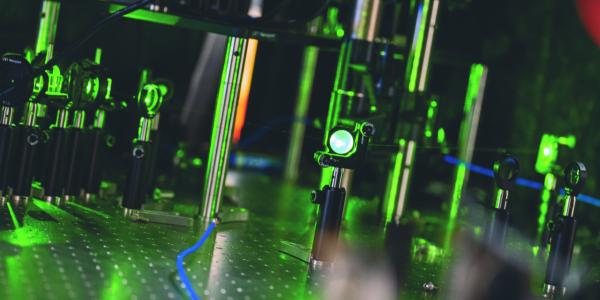Li Yang, the Albert Gordon Hill Professor of Physics, has been named a 2025 Fellow of the American Physical Society (APS). The APS, an international organization with more than 50,000 members, awards fellowships to physicists who have demonstrated excellence in research, teaching, and advancing the field. Candidates are nominated by their peers.

“This fellowship is a great honor,” Yang said. “Several other physics faculty members at WashU are also APS fellows, which speaks to the strength of the entire department.”
In its award announcement, the APS highlighted Yang’s computational approach to low-dimensional quantum materials. As a member of the Institute of Materials Science & Engineering and the Center for Quantum Leaps, Yang uses high-performance supercomputers to predict the optical, magnetic, and electronic properties of ultrathin materials at the nanoscale level.
“We harness computers to predict how electrons will interact and design new material properties based on these quantum interactions,” he explained.
Yang’s work serves as a critical guide for experimental scientists. Once his simulations identify materials with promising properties, he collaborates with researchers to create them in their labs. “In many cases, the materials fit our predictions closely,” Yang noted. “Without computational predictions as a guide, most attempts to build novel materials with specific properties would be incredibly time- and cost-consuming.”
Even with vast computing power, making meaningful predictions about future materials demands patience and a deep understanding of quantum possibilities. “There can be trillions of electrons in a simple quantum material,” Yang said. “There are incredible levels of complexity.”
More than a decade ago, computer simulations from Yang’s team predicted that light can create quantum “bubbles” in ultrathin sheets of phosphorus, also known as black phosphorus. These “bubbles” can bind with electrons to form pairs, creating novel optical responses within the middle-infrared frequency range. This discovery was selected as a milestone in the Physical Review B 50th Anniversary Milestones by APS in 2020. Yang and his collaborators, alongside researchers worldwide, continue to apply these findings in the search for next-generation optoelectronic and telecommunication technologies.
Among other current projects, Yang is employing data mining and artificial intelligence to accelerate the discovery of materials for spintronics. His work focuses on controlling the spins of electrons, instead of their charge, to avoid overheating. This approach is promising for energy-efficient logic or memory devices.
Yang emphasized the importance of scientific collaboration in his research, which requires a comprehensive scope, including material fabrication, characterization, measurements, device implementation, and quantum simulations. “Such a team, aligned with the U.S. national interest in quantum information, artificial intelligence, and the materials genome initiative, will create new science and applications to improve our society,” he said.




